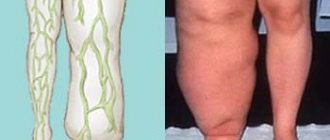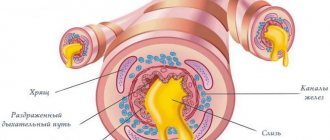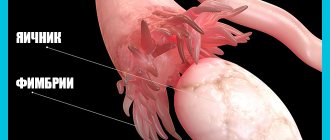Classification
Almost always, milk secretion from the breast is accompanied by an increase in prolactin levels. But in some cases, hormone levels are normal. Galactorrhea with normal prolactin occurs if the ducts of the mammary glands are dilated, as well as in unclear clinical cases. Treatment in such situations is based on correcting the functioning of all internal organs, normalizing lifestyle and nutrition. Galactorrhea is not always associated with childbirth. The classification of galactorrhea is presented in the table.
Table - Classification of the disease
| Criteria | Classification |
| By prevalence | — One-sided; — two-sided |
| According to the nature of secretion leakage | — Light (I); - moderate (II); - pronounced (III) |
| By etiology | - Not associated with childbirth (ICD-10 galactorrhea code in this case N64.3); - lactation (according to ICD-10 - O92.6) |
Galactorrhea is considered idiopathic, in which it is impossible to establish the true causes of the disorders.
Forecast
The prognosis for galactorrhea is generally favorable for life, health and reproduction of offspring. But to ensure its success, timely detection and adequate treatment of the described disease are important.
Kovtonyuk Oksana Vladimirovna, medical observer, surgeon, consultant doctor
just today
( 69 votes, average: 4.26 out of 5)
17th week of pregnancy: mother’s feelings, fetal development, possible problems
32 weeks of pregnancy: what happens to the fetus and how does the woman feel?
Related Posts
Galactorrhea of the mammary gland: what is it and why does it occur?
Galactorrhea is typical for women of reproductive age. This is not a disease, but a symptom, a consequence of hormonal imbalance or serious pathologies in the body.
Excursion into physiology
To identify the reasons for such “lactation”, it is important to understand how milk is produced in the female body. Regulation of the functioning of the mammary glands occurs “along a chain” - a system of direct and feedback between structures.
- Pituitary. A small but very important section in the brain. It synthesizes many hormones that coordinate the work of all internal organs. Prolactin is also formed here, acting directly on the mammary glands and being responsible for the production of breast milk.
- Hypothalamus. A second, no less important area of the brain releases dopamine, a substance that suppresses the synthesis of prolactin when its action is inappropriate.
- Thyroid. Malfunction leads to changes in the secretion of thyroid-stimulating hormones in the pituitary gland, and they increase the production of prolactin.
Causes of the disease
Disruption of even one link in the chain leads to various problems with the production of breast milk. The following causes of galactorrhea can be distinguished.
- Disorders at the level of the pituitary gland. Prolactinoma (pituitary adenoma) is a hormonally active benign neoplasm that leads to excessive production of prolactin. In 95% of cases, it is several millimeters in size and is detected only with targeted CT or MRI of the brain. It does not compress the surrounding nervous tissue and is usually asymptomatic, but if you experience headaches, depression or blurred vision due to prolactinoma, you should consult a specialist.
- Disorders at the level of the hypothalamus. These brain structures influence the production of dopamine, which protects against excessive prolactin production. This is possible with Chiari-Frommel syndrome, when, due to disruption of the hypothalamus, the production of prolactin is not suppressed, it blocks the synthesis of follicle-stimulating hormone and therefore follicles do not mature in the ovary, amenorrhea appears and the menstrual cycle is disrupted. The syndrome is accompanied by galactorrhea, prolonged absence of menstruation and infertility, headaches, increased hair growth and weight problems. Disturbances in the hypothalamus can occur due to tumors, injuries, inflammation, sarcoidosis, and neurotuberculosis. Since this part of the brain is responsible for a large number of important processes, its damage makes itself felt by multiple disorders in the body - the functioning of all internal organs, the thyroid gland changes, and galactorrhea appears.
- Disorders of the thyroid gland. The conditions are always accompanied by an increase or decrease in the level of thyroid hormones (T3 and T4), to which the pituitary gland reacts and, through TSH (thyroid-stimulating hormone), tries to maintain the norm. The areas of production of TSH and prolactin are located nearby, so excess or insufficient secretion of one of them leads to changes in the level of the other. Hyperprolactinemia is more often diagnosed with hypothyroidism, less often with hyperthyroidism.
- Polycystic ovary syndrome. The pathology is characterized by a violation of the production of estrogen by the ovaries, to which the pituitary gland and hypothalamus react, and hyperprolactinemia occurs with galactorrhea.
- Medications. When taking Eglonil, oral contraceptives, other drugs with estrogens, dopamine antagonists, cimetidine, antidepressants, a side effect in the form of galactorrhea may occur. The decision to continue treatment with these drugs against the background of breast discharge is decided by the doctor; in most cases, it is recommended to abandon the drug and replace it with an alternative one.
- Liver and kidney failure. Metabolism of reproductive organs and prolactin occurs in the liver. The kidneys are involved in the excretion of metabolic products. Diseases that disrupt the functioning of these organs indirectly lead to hyperprolactinemia.
Active stimulation of the nipples during sexual intercourse or wearing a tight bra can cause galactorrhea. Diseases, injuries of the spinal cord and spine are also included in the list of causes.
Symptoms of the disease
The main symptom of galactorrhea is the discharge of white fluid from the nipples. This may be watery milk or thicker colostrum, a slightly whitish secretion. The liquid is released in the form of several drops or leaks in a fairly large amount - in a stream. One or both breasts are affected. The condition should not be accompanied by discomfort, and the secreted milk should not contain blood impurities. Such signs are especially dangerous in premenopause. Otherwise, we are talking about other breast diseases, including malignant tumors. There are three degrees of galactorrhea, which are presented in the table.
Table - Degrees of galactorrhea
| Degree | Characteristic |
| I | Drops of secretion appear during palpation and pressing on the chest |
| II | Milk comes out in a stream |
| III | The secret flows out independently and constantly |
Secretion may be accompanied by the following symptoms:
- enlargement and pain in the mammary glands;
- increased nipple sensitivity;
- hyperemia and maceration of the skin in the nipple area;
- traces of discharge on clothes.
In men, hyperprolactinemia can be accompanied by gynecomastia - breast enlargement, as well as decreased libido and potency.
In diseases of the hypothalamus, accompanying symptoms may include amenorrhea, headaches, problems with vision and sleep. Disturbances in the pituitary gland often lead to menstrual disorders, infertility, and osteoporosis. They are also accompanied by signs of hyperandrogenism (increased levels of male sex hormones).
Possible complications
With timely contact with a medical specialist and proper treatment, the pathology disappears without consequences for the body. But an advanced disease can cause serious harm to health, even lead to disability.
The main complications of galactorrhea are:
- Hypothyroid coma. Occurs when galactorrhea is a symptom of thyroid dysfunction. The patient becomes unconscious and blood pressure drops significantly. Fluid accumulates in the internal tissues, causing swelling of the heart, brain, and lungs.
- Stroke. A consequence of the appearance of a tumor in the pituitary gland, which interferes with blood circulation in the brain tissue. With tumors in the internal parts of the brain, there is a high probability of hemorrhage and complete or partial loss of visual ability.
- Metastasis in oncological diseases of the pulmonary system. Malignant cells spread through the blood and lymphatic channels to other organs. If lung cancer is advanced and brought to the last stage, then there is a high probability of death.
- Infertility. A consequence of hormonal imbalance caused by excessive synthesis of prolactin. After childbirth, the hypothalamus reduces the synthesis of dopamine, a hormone that inhibits the formation of prolactin. With the end of the lactation period, dopamine synthesis is restored, due to which the production of prolactin is kept under control. With normal prolactin, the production of colostrum outside the lactation period is impossible , but if the control mechanism is disrupted, then galactorrhea develops, the menstrual cycle is disrupted, which leads to infertility.
- Mastopathy. Prolactin provokes the proliferation of epithelial tissue of the mammary glands, makes tissue receptors more sensitive to estrogen, and increases the concentration of prostaglandins. Due to excess prostaglandins, the permeability and patency of breast vessels changes, the circulation of blood and salt ions in the breast tissue is disrupted, and increased prolactin accelerates metabolism in the mammary glands. Therefore, with mastopathy, pathological discharge from the nipples is often observed.
When is it considered normal?
Milk secretion from the breast may be a consequence of permissible hormonal changes in a woman’s body.
- During pregnancy. The lactation process begins long before childbirth, so already during pregnancy, a woman may notice the production of milk or colostrum in one breast or in two at once.
- After the birth of the child. Natural lactation begins after childbirth and continues as long as the woman breastfeeds and attaches the baby to her.
- After completion of lactation. The process of milk production can continue for up to two or even three years after a woman stops breastfeeding. The secretion is not so intense - when you press on the areola area, a few drops of whitish liquid are released. The level of hormones that regulate milk synthesis gradually returns to normal and the manifestations of galactorrhea disappear.
Signs of the disease
We have already indicated the most characteristic sign of galactorrhea - the secretion of milk from the mammary glands (either from one or both at once). Acute pathological discharges in this case are those that contain impurities of blood or pus.
Other accompanying signs of galactorrhea are:
- Severe headaches close to migraine;
- Decreased vision;
- Decreased sexual desire in both men and women;
- Allergic reaction to the skin - pimples, numerous blackheads, comedones;
- In women - menstrual dysfunction;
- Increased hair growth on the chest in women, which indicates a hormonal imbalance and a certain malfunction in the body.
The presence of at least one of the above symptoms gives grounds for the patient to seek advice from a mammologist.
Examination: specialists and tests
The cause of galactorrhea not associated with lactation is determined through a series of studies. First of all, it is necessary to exclude pregnancy. In the future, the diagnostic methods presented in the table are used.
Table - Examination for galactorrhea
| Method | Why is it carried out? |
| Inspection and palpation | To assess the appearance of the breast and identify lumps |
| Gynecological history collection | To obtain data on the menstrual cycle, the presence of diseases of the reproductive system |
| Blood tests for hormones | — To control the functioning of the thyroid gland (T3, T4 and TSH); - to control the functioning of the genital organs and adrenal glands (estradiol, progesterone, testosterone, DHEA); - to control the functioning of the pituitary gland (prolactin, macroprolactin share) |
| Consultation with an ophthalmologist and neurologist | To exclude a tumor process in the brain |
| MRI or CT | For diagnosing tumors in the brain or other organs |
| Ultrasound of the pelvis, adrenal glands, mammary glands, mammography | To study the structure of organs and identify abnormalities |
How to take prolactin correctly
Prolactin is not only responsible for milk production, it is a stress hormone. To obtain correct test results, you must donate blood under the following conditions:
- carry out blood sampling from 8:00 to 11:00 - in the early morning the concentration of prolactin is maximum, and in the evening it is minimum;
- avoid irritation of the nipples, having sex the day before - this leads to an artificial increase in the level of the hormone;
- Avoid excessive physical activity for several days before the test;
- avoid stress - even fear of the procedure for drawing blood or worry about how to quickly get to the laboratory can lead to a false result.
Normal prolactin levels are presented in the table.
Table - The result of the test for prolactin is normal
| Index | Norm |
| Prolactin | 4.1-60 ng/ml or up to 600 µU/ml |
| Proportion of macroprolactin | At least 40% |
The release of milk secretion from the breast, not related to lactation, is a reason to contact a gynecologist, mammologist, endocrinologist or oncologist.
Treatment
Galactorrhea is not an independent disease - it is a symptom of pathological conditions. And in order to get rid of it, it is necessary to eliminate the root cause of the violations. Often the problem lies in changes in the regulation of brain structures and hormone imbalance. If galactorrhea is a complication caused by medications, you should stop using them.
Treatment is usually medicinal and includes taking drugs that suppress prolactin secretion. Sometimes it is completely impossible to eliminate the cause of galactorrhea, so you have to take medications constantly. Taking into account contraindications for use, dopamine agonists are prescribed, which simulate and enhance the effect of this substance and reduce the intensity of prolactin synthesis.
Surgical treatment is initiated in the presence of a brain tumor, which is accompanied by other symptoms - headache, dizziness. Radiation therapy is rarely used to remove a tumor in the pituitary gland or hypothalamus.
The table shows the main drugs and their dosage regimens for hyperprolactinemic galactorrhea.
Table - How to treat breast galactorrhea with elevated prolactin
| Drugs | Reception features |
| "Bromocriptine", "Parlodel" | 1/4 tablet daily, increasing the dose if necessary to 1-2 tablets per day |
| "Dostinex" | — Start with 1/2 tablet 1-2 times a week; - gradually increase the dose until prolactin levels normalize |
With a slight increase in prolactin levels and accompanying symptoms of mastodynia (chest pain), herbal medicines, dietary supplements, and homeopathic remedies can be prescribed. It is popular to use Mastodinone, one capsule daily.
Traditional methods
The following herbs can be used to lower prolactin levels. However, they should not be given preference in case of serious disorders or tumors. Folk remedies will help with minor functional disorders.
- Periwinkle. Pour two tablespoons into 500 ml of hot water in a thermos in the evening. The next day, use 150 ml three times a day.
- Sage. You can eat half a teaspoon in the morning with plenty of water. You can prepare a solution. To do this, brew one tablespoon of leaves in a glass of water and drink it instead of tea - two to three times a day.
- Sorrel. Pour 10 g of crushed sorrel root into 200 ml of boiling water and leave for two to three hours. Take one to two tablespoons per day.
- Bee pollen. Take a tablespoon in the morning, lunch and evening.
The course of treatment with folk remedies is determined individually - until the symptoms of the disease decrease or disappear.
Infertility
Galactorrhea often accompanies infertility - this is why it is dangerous. An increase in prolactin levels disrupts the growth and maturation of follicles and provokes anovulation. Pregnancy is possible only against the background of correction of hormone levels with drugs. They are taken during planning, as preparation for IVF, and after confirmation of pregnancy, cancellation is almost always recommended. Regimen for the use of prolactin-lowering medications are agreed upon individually with the attending physician.
Treatment of galactorrhea should begin with a full examination and identification of the cause of the failure. However, reviews from women and doctors indicate that sometimes it is not possible to understand at what level the violations occurred.
How to treat?
Treatment for galactorrhea depends on the cause of the disease. As soon as the true cause of the increased secretion of the hormone prolactin is established, then treatment can begin. Therapy, as a rule, consists of medication and most often hormones. Parlodel and Dostinex (in women) are used to normalize hormonal levels.
If the disease (galactorrhea) has caused serious complications, then in this case urgent hospitalization is necessary, including intensive care.












